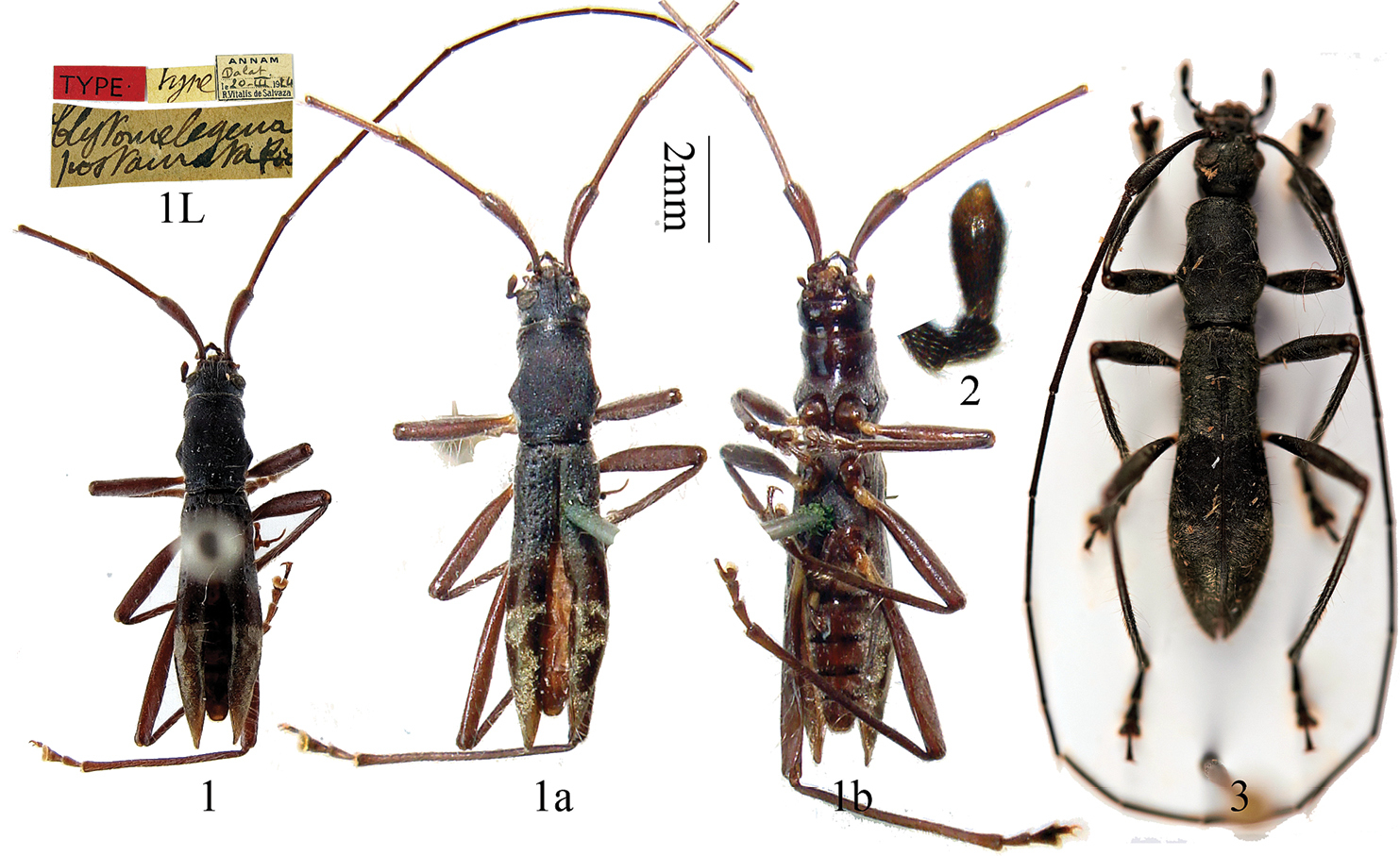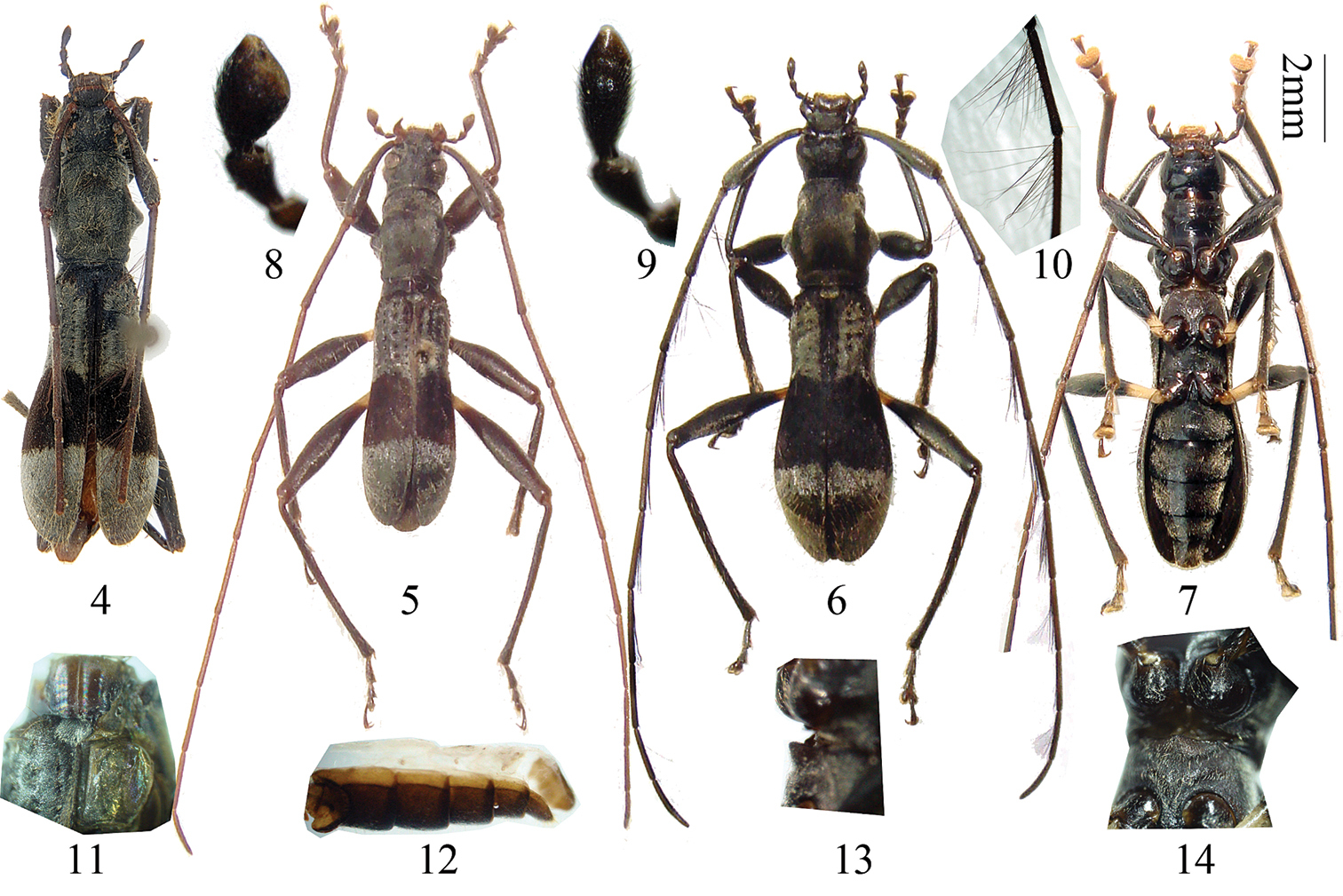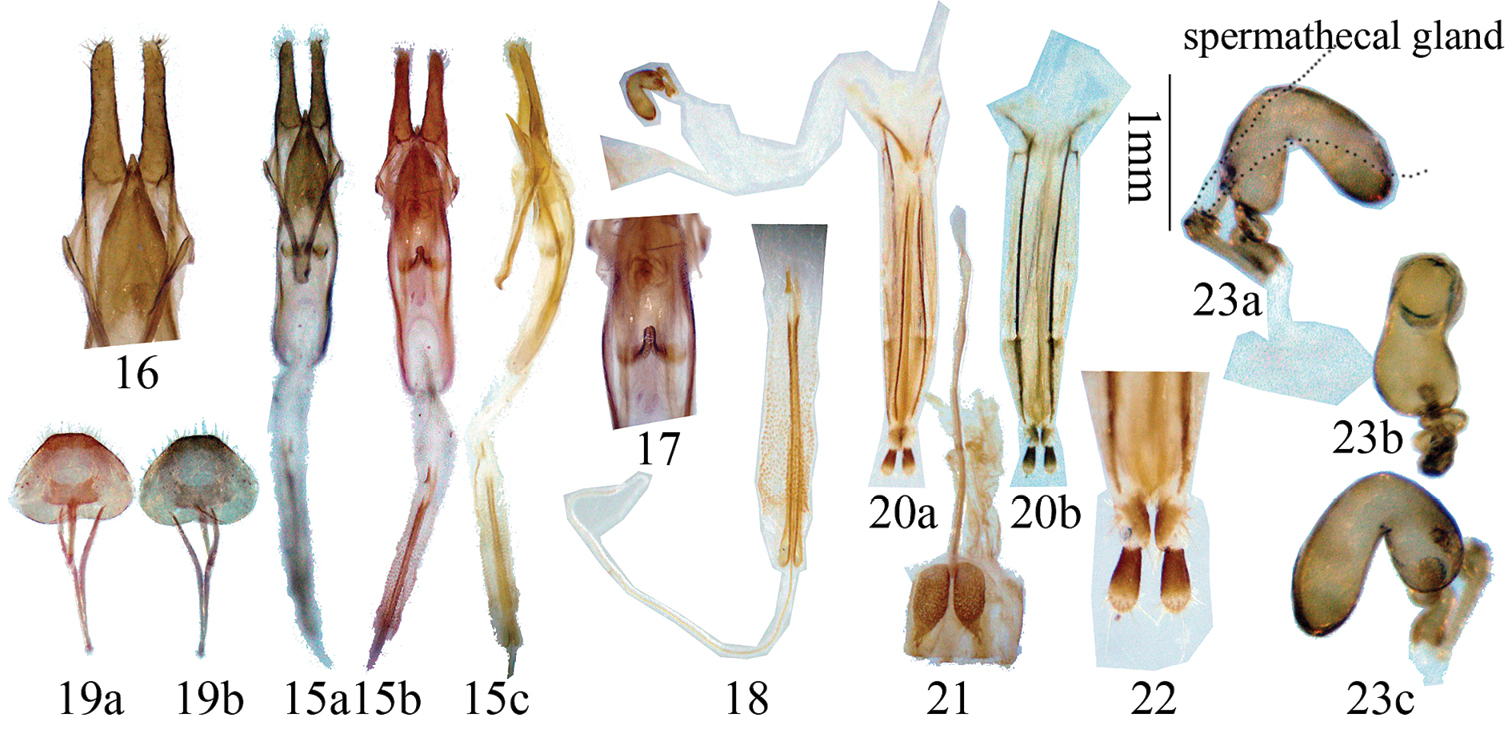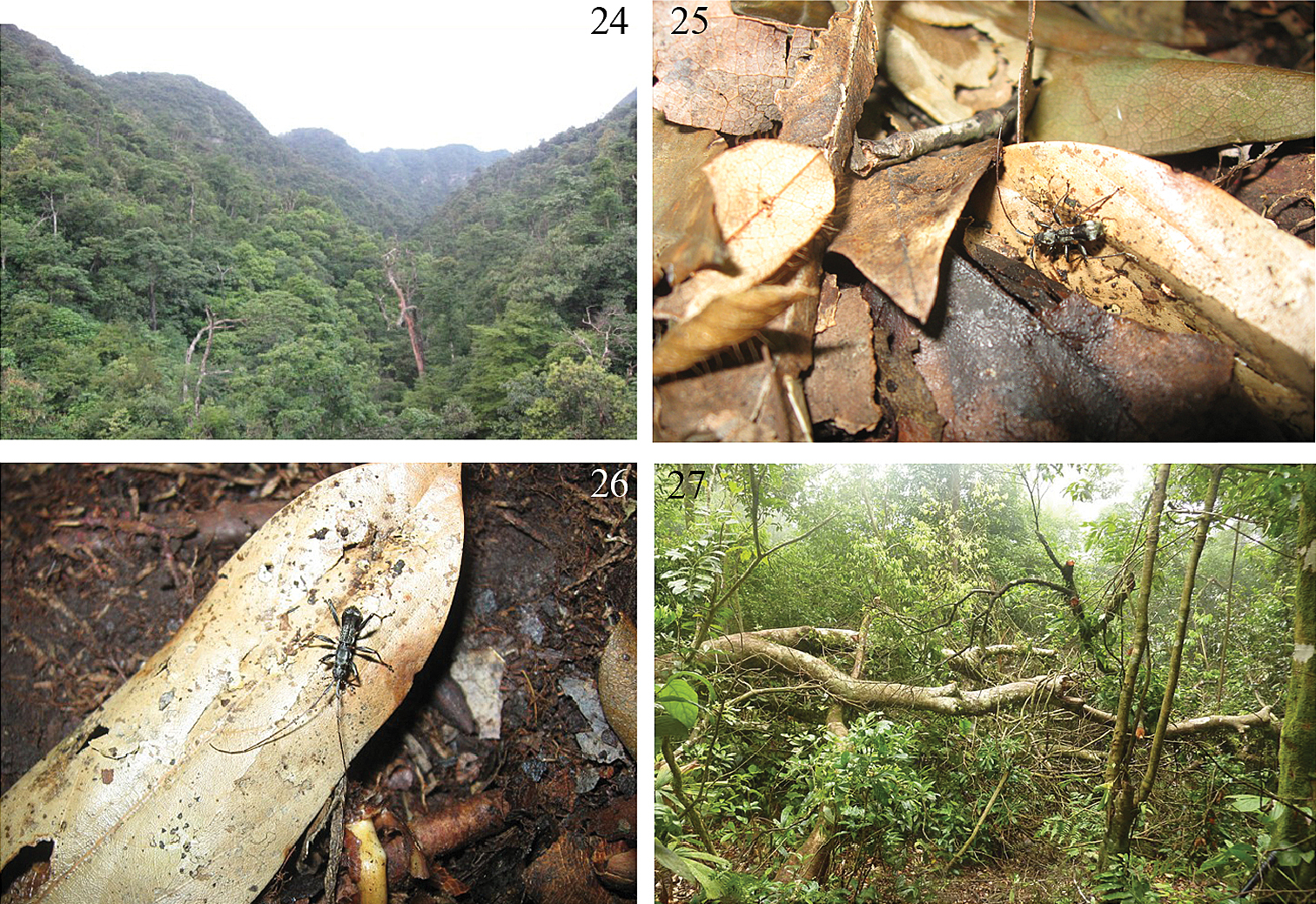






(C) 2012 Meiying Lin. This is an open access article distributed under the terms of the Creative Commons Attribution License 3.0 (CC-BY), which permits unrestricted use, distribution, and reproduction in any medium, provided the original author and source are credited.
For reference, use of the paginated PDF or printed version of this article is recommended.
The genusNoeconia Murzin, 1988 is synonymized with Clytomelegena Pic, 1928. Clytomelegena kabakovi (Murzin, 1988), comb. n. is newly recorded from China (Guangxi Prov.). And Laos (Attapeu Prov.) is a new locality of this genus. Both sexes are apterous. Photographs and genitalic descriptions of Clytomelegena kabakovi are presented for the first time.
Clytomelegena Pic , Noeconia Murzin , new synonym, new combination, new locality, Oriental region, Disteniidae
The first author, Meiying Lin found an old strange Distenidae specimen in the collection of the Chinese Agriculture University in Beijing in the past. Surprisingly in 2011, additional specimens collected at the same locality in China were brought to her by Messrs. Xinlei Huang and Huihua Zeng. It was first determined as Noeconia kabakovi Murzin, 1988 with the help of her European friends. Later, the second author, Sergey V. Murzin visited her Institute and informed her that Noeconia kabakovi could be a synonym of Clytomelegena postaurata Pic, 1928.
The genus Clytomelegena was first described by
According to our study of the type specimens of these two genera, it is concluded that the genus Noeconia should be a synonym of Clytomelegena by the resemblance of the structures of antennae, prothorax, elytra, abdomen and lack of hind wings. However, these two species are thought to be different species in spite of the problem that the type specimen of Clytomelegena postaurata seems to be a teneral individual.
As luck would have it, one specimen collected in Laos was brought to us as an addition to the abnormal unique type of Clytomelegena postaurata, which suggests that Clytomelegena postaurata and Noeconia kabakovi are surely different species, and the elytral shape could be a useful character to separate species. As a result, it is indicated that Clytomelegena postaurata is distributed in South Vietnam and Laos, and Noeconia kabakovi is distributed in North Vietnam and South China. The Chinese fauna of the Disteniidae is thus updated to 3 tribes, 8 genera and 28 species (
Types and other material studied are deposited in the following institutions or private collections:
CAU China Agricultural University, Beijing, China
CWD Private collection of Dong Wen, Qingdao, Shandong, China
EVC Eduard Vives collection, Terrass a, Spain
IEER A. N. Severtzov Institute of Ecology and Evolution (=IEMEA, A. N. Severtzov Institute of Evolutionary Morphology and Ecology of Animals), Moscow, Russia
IZAS Institute of Zoology, Chinese Academy of Sciences, Beijing, China
MNHN Muséum National d’Histoire Naturelle, Paris, France
NMPC National museum, Prague, Czech Republic
USNM National Museum of Natural History, Smithsonian Institution, Washington, DC, USA
ZIN Zoological Institute, Saint-Petersburg, Russia
Resultshttp://species-id.net/wiki/Clytomelegena
Body small, slender; elytra not wider than prothorax at humeri and widened behind middle. Eyes finely faceted, oval; with very small emargination. Prothorax subequal to or more than 1.5 times as long as basal width, with round lateral tubercles behind middle; with a slight apical constriction, apical part subequal to or a little narrower than base. Scutellum pentagonal. Elytra depressed behind scutellum, swollen behind middle, evenly rounded apically. Hind wings reduced (Fig. 11; not mentioned in either of the original descriptions). Antennae thin, about 1.5 to 1.8 times as long as body, 3rd to 10th antennal joints internally with recumbent undulating long hairs, reaching the apex of corresponding joint. Procoxal cavity open behind (Fig. 14). Femora spindle-shaped, petiolate (Fig. 7); male hind femora reach elytral apex. Middle tibiae with an oblique groove bearing a brush of hairs. 1st joint of posterior tarsi shorter than or subequal to following two joints together.
The genus belongs to the tribe Disteniini, close to Nericonia Pascoe and Noemia Pascoe, but differs by having the elytra swollen (
Two flightless Oriental genera are known up to now: Clytomelegena Pic, 1928 and Olemehlia Holzschuh, 2011.
China (new country record): Guangxi Prov.; Laos (new country record): Attapeu Prov.; Vietnam: Vinh Phuc Prov., Batkhay Prov., Ninh Binh Prov. (Cuc Phuong National Park, new province record), Cao Bang Prov. (new province record), Lamdong Prov.
http://species-id.net/wiki/Clytomelegena_postaurata
Figs 1–2The unique type specimen deposited in MNHN is a newly emergent individual, which is difficult to compare with other specimens. The testaceous antennae and legs could be its color, or they would become as dark as the specimen from Laos or same to Murzin’s kabakovi. The elytra are not fully sclerotized, making specific character coding such as maculae unclear but revealing the absence of hind wings without opening the elytra. The last segment of maxillary palp (Fig. 2) and the last visible sternite (Fig. 1b) indicate that it is a female.
Measurement on the holotype: Elytra length: humeral width = ca. 3.5; pronotum length: pronotum maximum width = ca. 1.2; elytra length: prothorax length = ca. 2.7.
The relative length of antennal joints: 17:0.5:18:17:18:18:17:16:15:14:11.
Clytomelegena postaurata Pic, 1928. 1 Holotype of Clytomelegena postaurata Pic, female, from Annam of Vietnam. a dorsal view b ventral view. L. labels 2 showing the shape of last segment of maxillary palp, in dorsal view 3 Clytomelegena sp., a female from Attapeu Prov. of Laos, similar to Clytomelegena postaurata. 1a & 1b scale 2 mm, others not to scale.
Holotype (Fig. 1) of Clytomelegena postaurata Pic, female, Vietnam, Annam, Dalat (South Vietnam, LamDong Prov.) (MNHN, ex collection M. Pic).
Vietnam (LamDong Prov.).
The female from Laos is more similar to Pic’s postaurata than Murzin’s kabakovi based on the measurement and the shape of elytral apex.
Measurement of the Clytomelegena sp. from Laos: Elytra length: humeral width = ca. 4.0; pronotum length: pronotum maximum width = ca. 1.3; elytra length: prothorax length = ca. 2.6.
1 female, Laos, Attapeu Prov., Annam Highlands Mts., Dong Amphan NBCA, ca 1, 160 m, Nong Fa (Crater Lake env.), 15°05.9'N, 107°25.6'E, 2010.IV.30–V.6, Jiři Hájek leg (NMPC).
http://species-id.net/wiki/Clytomelegena_kabakovi
Figs 4–27Body length 8.8–14.5 mm, width at humeri 1.7–2.2 mm. Black; trochanters and bases of femora yellow; mouth parts, most parts of legs and antennae brownish. Body with long scattered erect setae and recumbent silvery pubescence, which is sparser on head and abdominal sternites and absent on ventral sides of head and prothorax. Elytra with a transverse band behind middle created by recumbent dark-brown setae and pubescence, of which width is about 1/4 of elytral length.
Head finely irregularly rugose between eyes, with longitudinal rugose sculpture under eyes and behind antennal bases. The last segment of maxillary palp stout (male, Fig. 8) or slender (female, Fig. 9). Pronotum longer than broad, with very fine and dense punctation. Elytra with 4 longitudinal rows of punctures, which are deep and hollow-shaped anteriorly and missing at middle, with very fine indistinct sculpturing between punctures, independently rounded apically, with a row of 7–10 pointed tubercles behind humeri. Antennae long and thin, 1.5 (female) to 1.8 (male) times longer than body; Scape dilated toward apex, reaching midlength of pronotum. Pedicel very small, spherical, hidden inside apical hollow of scape. The relative length of antennal joints (male and female almost same): 20:1:19:17:18:18:17:16:15:13:14.
Clytomelegena kabakovi (Murzin, 1988). 4–7 Habitus. 4 female, from Tonkin of Vietnam 5 male, from Guangxi of China 6 female in dorsal view, from Guangxi of China 7 female in ventral view, from Guangxi of China. 8–9 showing last segment of maxillary palp. 8 male 9 female. 10 showing the fringed long hairs of antennomeres 11 showing mesonotum with a median groove and hind wings reduced (right elytron removed) 12 lateral view of male abdomen, showing membranous tergites (except tergite VII) 13 mesosernum in lateral view, showing median basal part protruding 14 procoxal cavity, open posteriorly. 4–7 Scale 2 mm. 8–14 not to scale.
Measurement on male: Elytra length: humeral width = ca. 3.1; pronotum length: pronotum maximum width = ca. 1.1; elytra length: prothorax length = ca. 2.5.
Measurement on the female: Elytra length: humeral width = ca. 3.2; pronotum length: pronotum maximum width = ca. 1.1; elytra length: prothorax length = ca. 2.6.
(Figs 15–19): Tegmen approximately 1.6 mm in length; lateral lobes slender, approximately 0.5 mm long and 0.1 mm wide, apex with short setae; median lobe plus median struts slightly curved, subequal to tegmen in length; the median struts less than 1/3 of the whole median lobe in length; dorsal plate shorter than ventral plate; apex of ventral plate sharply pointed; internal sac moderately long, about twice the median lobe in length, bearing a basal armature (Fig. 17) and two apical rods of endophallus (Fig. 18), ejaculatory duct single (Fig. 18). Apex of tergite VIII truncated with rounded sides (Fig. 19). Female terminalia (Figs 20–23): Paraproct moderate in size, its baculi thick and long, straight and not bifurcate at base; valvifer baculum very thick at base and narrowed towards apex (Fig. 20b); coxite lobes sclerotized at each inner part, with tactile hairs; stylus articulated to the tip of each coxite lobe, sclerotized except for apex and bearing tactile hairs (Fig. 22); dorsal baculi straight and longer than paraproct baculi (Fig. 20a); proctiger baculi long and almost straight (Fig. 20a). Spermathecal capsule (Fig. 23) is complex and coiled, composed of two parts, with two openings to bursa copulatrix (or spermathecal duct); bigger one with basal 1/4 twisted, strongly curved near middle; the other small part also strongly sclerotized, curved and twisted at middle, connected with bigger part with a thin duct; spermathecal gland (Fig. 23a) attached to middle of smaller part of capsule, membranous. Tignum (Fig. 21) slightly longer than half of abdomen. In one measured specimen, tignum was 2.3 mm for an adult with 4.2 mm abdomen length in ventral view.
Genitalia of Clytomelegena kabakovi (Murzin, 1988). 15–19 male. 15 male genitalia 16 showing lateral lobes and apex of ventral plate 17 showing basal armature in intersal sac 18 showing rods of endophallus and ejaculatory duct 19 tergite VIII and sternites VIII & IX in ventral view. a ventral view b dorsal view c lateral view. 20–23 female. 20 female genitalia. a dorsal view b ventral view 21 tignum, ventral view 22 showing stylus 23 spermathecal capsule in different views. 15, 19, 20, 21 scale 1 mm, others not to scale.
Prior to this study, no biological or ecological information was published on this species. The second author S. Murzin collected some specimens of this species in Cuc Phuong National Park (N. Vietnam) on 3–5 May 1991 on leaves of different plants. On 5 June 2011, Huihua Zeng collected one specimen on the ground near a light trap, but it was not certain whether this was an accidental occurrence or whether the specimen was attracted by light. Later (9 July 2011), the same collector observed another specimen on a stump near the light trap, later crawling in the leaf litter on the ground (
Eduard Vives collected one female on 14 June 2011 in Tam Dao National Park of North Vietnam. It was crawling in a very antlike manner on the trunk of a large, recently fallen tree (
In 2012, 3 additional specimens were collected in North Vietnam from Cao Bang Province and Ninh Binh Province in April and May by an expedition of Steven Lingafelter, Eduard Jendek, and Pham Hong Thai.
Biotope of Clytomelegena kabakovi (Murzin, 1988). 24 tropical rainforest of collecting site in Guangxi, China (by Huihua Zeng) 25–26 crawling on the leaf litter near light trap site (by Huihua Zeng) 27 collecting site in Tam Dao National Park of North Vietnam (by E. Vives).
We consider Murzin’s kabakovi a different species from Pic’s postaurata based on the following reasons:
1) Elytron with a row of 7–10 pointed tubercles behind humeri, while tubercles missing in Clytomelegena postaurata (based on the unique type specimen);
2) Elytral apex broader (bluntly rounded instead of sharply rounded) and elytra shorter (the ratio of elytral length to basal width smaller);
3) Antennomere XI slight longer than antennomere X (much shorter in Clytomelegena postaurata)
4) Hairs on elytra much shorter;
5) Pronotum with bigger lateral tubercles and swellings on the sides of the disc not as flattened as that on Clytomelegena postaurata;
6) Width of the dark-brown transverse band behind middle of elytra is about 1/4 of elytral length, while in Clytomelegena postaurata is only 1/6.
This species is recorded from China for the first time. It is the 28th recorded species for the Chinese Disteniidae fauna.
China (new country record): Guangxi Prov.; Vietnam: Vinh Phuc Prov., Batkhay Prov., Ninh Binh Prov. (Cuc Phuong National Park, new province record), Cao Bang Prov. (new province record).
Type series of Noeconia kabakovi Murzin, 1988. Holotype, male, Batkhay Prov.: mountains in 50 km N-E Tkhaynguen, 1963.V.14, coll. O.N. Kabakov; paratype, 1 female, (Bakthai Prov.), distr. Fulyong, village Kuangtchu, 1986.IV.23, coll. A.V. Sharkov; paratype, 1 female, Prov. Vin’fu; Tamdao, alt. 800m, 1962.V.14, coll. O.N.Kabakov. All the types were preserved in the collections of IEER and ZIN.
Specimens from China, Guangxi: 1 male, Nanning, Wuming county, Mt. Damingshan, 1963.V.21, coll. Jikun Yang (CAU); 1 female, Nanning, Wuming county, Mt. Damingshan, Tianping station, alt. 900–1, 260 m, 23.51770°N, 108.39295°E, 2011.V.23, by sweeping net, coll. Xinlei Huang (IZAS); 1 female, Nanning, Wuming county, Mt. Damingshan, alt. 1200 m, 2011.VI.5, coll. Huihua Zeng (CWD); 1 female, same data but 2011.VII.9 (CWD).
Specimen from North Vietnam: 1 female, Vietnam North, Prov. Vinh Phuc, Tam Dao National Park, 1, 100 m, 2011.VI.14, coll. Eduard Vives (EVC); 2 females, Cao Bang Prov., Phja-Den Environs, 22°32.433'N, 105°52.012'E, alt. 948 m, 2012.V.2, day collecting, coll. Steven Lingafelter, Eduard Jendek, Pham Hong Thai (USNM); 1 female, Ninh Binh Prov., Cuc Phuong National Park, 20°21.012'N, 105°35.592'E, alt. 439 m, 2012.IV.25, day collecting, coll. Steven Lingafelter, Eduard Jendek, Pham Hong Thai (USNM).
We wish to express our sincere thanks to Mikhail Danilevsky (IEER), Petr Švácha (Institute of Entomology, Academy of Sciences, Ceske Budejovice, Czech Republic), Nobuo Ohbayashi (Miura City, Japan) and Steven W. Lingafelter (USNM) for improving this manuscript. We thank Akiko Saito (Natural History Museum & Institute, Chiba, Japan) for comments on female genitalia, Eduard Vives (Terrassa, Spain) for comments on biology. Our special thanks are due to Olivier Montreuil and Thierry Deuve (MNHN), Xinli Wang and Siliang Liu (CAU), Huihua Zeng and Dong Wen (CWD), Petr Viktora from Kutná Hora, Czech Republic, Tomá Tichý from Opava, Czech Republic, Steven W. Lingafelter (USNM) and Xinlei Huang (IZAS) for giving us the permission to use the related collections and supporting of materials and information. This research was supported by a grant (No. O529YX5105) from the Key Laboratory of the Zoological Systematics and Evolution of the Chinese Academy of Sciences, and by NSFC program J0930004 and 31000967.



